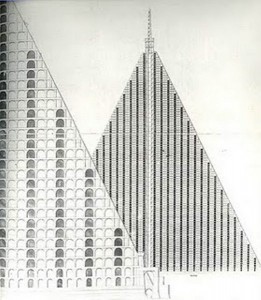By Marri Lynn (W&M Regular Contributor)
Finding an affordable, respectable place to live in Georgian or Victorian London was ever a problem, and one which citizens could not escape even in death. Overpopulation of the city’s major graveyards caused public scandals due to sanitation issues, as well as regular olfactory affronts and a macabre mockery of Christian dignity. As a result, innovators soon rushed to address this problem by proposing new graveyard sites, and new internment schemes.
One such innovator was named Thomas Willson. He would prove to be perhaps a little too innovative for the aesthetic, moral, and economic tastes of the day.
To house London’s dead, Willson prepared a blueprint of what would come to be called the Metropolitan Sepulchre. In Willson’s creative vision, a huge pyramidical structure would be built upon Primrose Hill, in North London, with a base as large as Russell Square and a tip towering nearly four times higher than St. Paul’s cathedral, to dominate the skyline. The vast pyramid would be constructed of brick with granite facing, and would have quarters for a keeper, clerk, sexton, and superintendent, as well as its own office and chapel. At full capacity, the Sepulchre would eventually house 5 million bodies.
Historian N.B. Penny called it a “nightmarish combination of megalomaniacal Neo-Classicism and dehumanized Utilitarian efficiency.” But for Willson, the pyramid was to be a “coup d’oeil of sepulchral magnificence unequalled in this world.” And it was a dream very nearly realized.
The financing behind the Sepulchre was sound. A company named the Pyramid General Cemetery Company had been set up to engage investors and produce stock. Calculating the cost of the pyramid against the selling prices of the family vaults it would contain, which were to fill up at a rate of 40,000 bodies annually, Willson and his associates stood to regain the project’s cost and then some. Their calculated profit margin was just under £11 million.
Willson presented his Sepulchre to Parliament, hopeful that they would grant the necessary charters to rubber stamp the project. He pitched his idea at the same time as an Inner Temple barrister named George Frederick Carden, who proposed a cemetery reminiscent of the garden-graveyards being produced by Père Lachaise in France. Willson allegedly withdrew his appeal before a Parliamentary verdict, in order to give opportunity to Carden, who was a co-worker at the General Cemetery Company.
The project lived on, albeit languishing in a mire of postponements and bad press. In 1828, the Literary Gazette called it ridiculous, a “monstrous piece of folly.” Plans and a small model remained on display at the National Repository at Charing Cross for two years, and eventually the Sepulchre received more friendly reportage. And at last, Willson’s proposal received the sincerest form of flattery: imitation, or rather, complete replication, by an architect in Paris.
Willson soon accused George Frederick Carden of intellectual theft, and published letters in John Bull to that effect. Carden responded by suing Willson for libel. It ended in public embarrassment for Willson, who was forced to pay libel damages and issue a public letter of apology, confessing to having written his letter in a fit of pique. Carden had taken the moral high ground by forgiving Willson, and came out of the affair clean.
The last whiff of Willson’s floundering pyramid scheme appears in the Great Exhibition of 1851, wherein a model of the ‘Great Victoria Pyramid’ attributed to a J. Willson or T. Willson was put on display. Willson had downsized his dream from an 18-acre megastructure to a more palatable 5-acre pyramid meant to house 625,000 bodies instead of 5 million. Willson’s affection for his project did not diminish, though after the Great Exhibition the public interest in entertaining thoughts of his curious Sepulchre sharply waned.
Imagine what a different place London would be, overlooked by the granite façade of the Metropolitan Sepulchre. Imagine, too, what work would keep historians of medicine and forensic anthropologists combing through its chambers of 5 million bodies. The pastoral landscapes of the garden cemeteries that were built instead may be less thrilling to behold and explore, but nevertheless they enjoy their own quiet victory over our urban landscapes.
Marri Lynn holds an MA in the History of Medicine at McGill University, Montreal (2011). She is currently studying French, while freelancing as a writer and copy editor. You can find out more at her About.me page.

